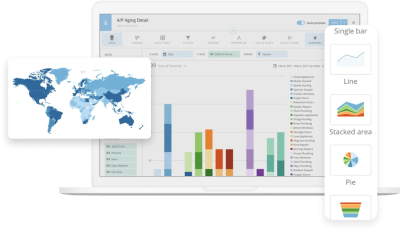Enhance your marketing strategy with a BI-powered marketing funnel app
As a marketer, you are always looking for ways to better understand your customers and their behavior. From understanding what drives them to purchase your product or service, to tracking their engagement with your brand, marketing funnel apps can help you get a 360-degree view of your customers.
As the amount of data we collect and store continues to grow, so do the possibilities for how we can use that data to improve our marketing efforts. Marketing funnel apps are one way that businesses can use data to their advantage.
By understanding how customers interact with your brand at each stage of the marketing funnel, you can tailor your marketing strategy to be more effective.
What is a marketing funnel app, and how can BI tools help you create one? In this article, we will break down the basics of marketing funnel apps and how you can use a BI tool to create a customized marketing funnel app for your business.
We will cover questions such as:
- What is a marketing funnel?
- What are the benefits of using a marketing funnel app?
- How can you use a BI tool to create a marketing funnel app?
- What features should your marketing funnel app have?
Understanding marketing funnels
A marketing funnel is the path that potential customers take from becoming aware of your brand.
Before we discuss building a marketing funnel app, it is important to understand what a marketing funnel is.
A marketing funnel is the path that potential customers take from becoming aware of your brand (at the top of the funnel) to becoming a paying customer (at the bottom of the funnel).
The goal of a marketing funnel is to convert as many leads as possible into paying customers.
There are typically four stages to a marketing funnel:
- Awareness: This is the stage where potential customers become aware of your brand.
- Interest: In this stage, potential customers learn more about your product or service and express interest in what you have to offer.
- Decision: Here, potential customers decide whether or not to purchase your product or service.
- Action: In the final stage, customers take action and purchase your product or service.
While the marketing funnel is a helpful way to think about the customer journey, it is important to remember that not all customers will follow this linear path.
Some customers may go straight from awareness to action, while others may go through the entire funnel multiple times before making a purchase.
The important thing is to track customer behavior so that you can tailor your marketing efforts accordingly.
This is where marketing funnel apps come in.

What is a marketing funnel app?
A marketing funnel app is a software application that helps businesses track and analyze customer behavior.
Marketing funnel apps allow businesses to see how customers interact with their brand at each stage of the marketing funnel.
This data can be used to improve marketing strategies and better understand what drives customers to purchase a product or service.
There are many different types of marketing funnel apps, but they all have one common goal: to help businesses convert more leads into paying customers.
Some of the features that marketing funnel apps offer include:
Lead tracking
Marketers can use marketing funnel apps to track how potential customers are interacting with their brand. This data can be used to better understand what drives customers to purchase a product or service.
Customer segmentation
Marketing funnel apps can help businesses segment their customers based on behavior. This allows businesses to tailor their marketing efforts to specific groups of customers.
A/B testing
Marketing funnel apps can also be used to test different marketing strategies (known as A/B testing). This helps businesses find the most effective way to reach their customers.
Reporting and analytics
Marketing funnel apps offer reporting and analytics features that allow businesses to track their progress and identify areas for improvement.
How to use a BI tool to create a marketing funnel app
Now that we’ve covered the basics of marketing funnel apps, let’s discuss how you can use a BI tool to create one.
Business intelligence tools allow companies to collect and analyze data. This data can be used to improve marketing strategies and better understand customer behavior.
When it comes to creating a marketing funnel app, a BI tool can be used to:
Collect data
BI tools can be used to collect data from multiple sources, including social media, website analytics, and customer surveys.
Clean and organize data
BI tools can help businesses clean and organize their data. This ensures that only accurate and reliable data is used to create the marketing funnel app.
Create reports and dashboards
BI tools can be used to create reports and dashboards that provide insights into customer behavior. This data can be used to improve marketing strategies and better understand what drives customers to purchase a product or service.
A/B test
BI tools can also be used to test different marketing strategies (known as A/B testing). This helps businesses find the most effective way to reach their customers.
How to build a BI-driven marketing funnel app
Now that we’ve covered the basics of marketing funnel apps and how to use a BI tool to create one, let’s discuss how you can build a BI-driven marketing funnel app.
There are many different ways to build a marketing funnel app, but the most important thing is to make sure that the app is able to collect and analyze data.
Here are some tips on how to build a BI-driven marketing funnel app:
Use a data management platform
A data management platform (DMP) is a software application that helps businesses collect and organize data. DMPs can be used to collect data from multiple sources, including social media, website analytics, and customer surveys.
Use a data visualization tool
Data visualization tools help businesses visualize their data. This makes it easier to understand and interpret customer behavior.
Use a reporting and analytics tool
Reporting and analytics tools help businesses track their progress and identify areas for improvement.
Use an A/B testing tool
A/B testing tools help businesses test different marketing strategies. This helps businesses find the most effective way to reach their customers.

When building your marketing funnel app, there are several steps you should take to ensure that you are using the best BI tools for your needs.
1. Define your goals
The first step is to define your goals. What do you want to achieve with your marketing funnel app? Do you want to improve customer acquisition? Increase customer loyalty? Improve customer retention? Once you’ve defined your goals, you can start to look for the right BI tools to help you achieve them.
2. Collect data via connectors
The next step is to collect data via connectors. Connectors are used to connect BI tools to data sources, such as social media, website analytics, and customer surveys.
3. Build reports and dashboard
Once you’ve collected your data, you can start to build reports and dashboards. Reports and dashboards help businesses track their progress and identify areas for improvement. Use the ideas above to develop the right visualizations and integrations that will help you achieve your goals.
4. Test and refine
The final step is to test and refine your marketing funnel app. A/B testing tools can help you test different marketing strategies. This will help you find the most effective way to reach your customers.
By following these steps, you can build a BI-driven marketing funnel app that will help you improve your marketing strategy and better understand customer behavior.
Tips for using a marketing funnel app
Now that you know how to build a BI-driven marketing funnel app, let’s discuss some tips for using it.
Here are some tips for using a marketing funnel app:
Use data filters
Data filters help businesses narrow down their data to only the most relevant information. This makes it easier to find trends and identify areas for improvement.
Set up alerts
Alerts help businesses stay on top of their data. They can be used to notify businesses when certain events happen, such as a customer reaching a certain milestone in their journey.
Use data export
Data export helps businesses share their data with other departments or teams. This is useful for collaboration and for developing marketing strategies.
Use data security
Data security is important for protecting customer data. Make sure to use a secure connection when sharing data with other departments or teams.
Share your app with appropriate people
After you’ve built your marketing funnel app, it’s important to share it with the appropriate people. This way, you can ensure that everyone is on the same page and that they are able to use the app to its full potential.
By following these tips, you can use your marketing funnel app to its full potential and improve your marketing strategy.
Conclusion
A marketing funnel app can be a powerful tool for businesses.
It can help businesses track their progress, understand customer behavior, and find areas for improvement. When building your marketing funnel app, make sure to use the best BI tools for your needs.
And finally, don’t forget to test and refine your app so that you can find the most effective way to reach your customers. Soon, you’ll have a powerful marketing tool that will help you take your business to the next level.
Start using a marketing funnel app today to improve your marketing strategy – and watch as your business grows with the power of BI data.
Check out some related resources:

Guide to Data Pipeline Design: Steps and Patterns

10 Power BI Alternatives and Competitors in 2025






